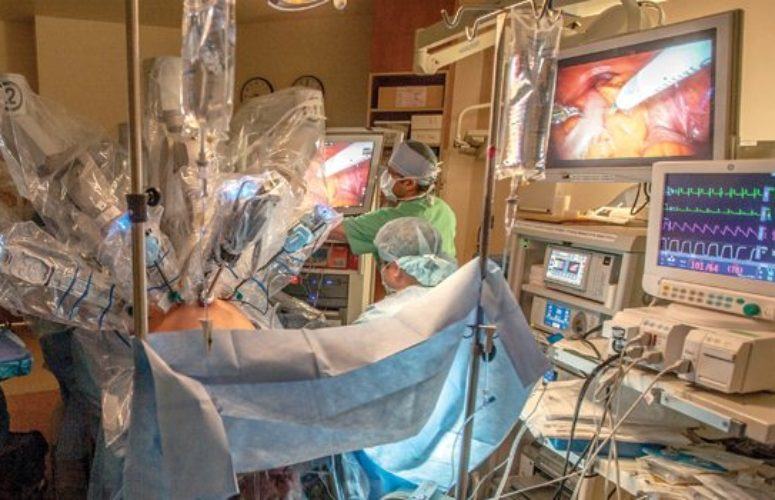
Living With Cancer
Cancer Diagnostics and Treatment
By Jennifer L. Nelson, Contributing Writer On Nov 25, 2014Nobody wants to hear the “c” word, but thanks to today’s state-of-the-art technologies, cancer is being diagnosed and treated more effectively than ever before. The Garden State’s hospitals and healthcare facilities remain on the cutting-edge of the latest diagnostic technologies and surgical techniques to help identify and treat cancer, and all while helping patients go on to lead long, healthy lives.
“We’re always keeping our eyes and ears open for new technologies and methods of combining different therapies in a way that will produce the best results for the patient,” says Dr. Henry K. Tsai, a radiation oncologist at ProCure Proton Therapy Center in Somerset. Princeton Radiation Oncology and CentraState Healthcare System joined ProCure to develop the first proton therapy center in the region, and the center provides patients with some of the most advanced proton therapy technology available.
“We have physicians who specialize in different types of cancer, and they: attend specialty conferences where cutting-edge information is provided; remain in touch with national thought leaders who communicate newer findings; and stay on top of the most up-to-date medical literature in their field,” adds Dr. Richard A. Michaelson, chief medical officer of the Cancer Center, Saint Barnabas Medical Center. “Now more than ever, cancer needs to be treated in a multidisciplinary manner with input from all appropriate specialties, including surgery, radiation oncology, medical oncology, interventional radiology, reconstructive surgery and rehabilitation medicine.”
According to Dr. Andrew Pecora, vice president of cancer services at the John Theurer Cancer Center at Hackensack University Medical Center and president of Regional Cancer Care Associates (the largest private practice of oncologists in the state), among the most promising advances in cancer diagnostics are happening at the molecular level. The hospital offers an array of molecular-based tests that provides not only a faster diagnosis, but a more comprehensive understanding of the tumor and what form of treatment will prove most effective for the patient. “Two women may have breast cancer that looks exactly the same under the microscope, but if the tumors are different at the molecular level, one woman may require chemotherapy while the other may not,” he says.
Dr. Shridar Ganesan, associate director for translational science and medical oncologist at Rutgers Cancer Institute of New Jersey and medical oncologist at Robert Wood Johnson University Hospital, notes that the study of genomes has also led to groundbreaking methods of detecting and understanding various forms of cancer. By looking beyond the microscope to study specific patterns of genomic changes driving the development of the tumor, genome sequencing is helping doctors better classify a patient’s cancer and can ultimately lead to the development of medications that are better targeted to attack a specific subset of cancer cells. “The idea has been around for a while, but now – in addition to a faster diagnosis – we’re able to understand exactly which drugs will work best on a specific tumor,” Ganesan says. “A lot has to be done in the way of research and clinical trials, but it’s exciting to think that it could lead to drugs that attack these very specific mutations.”
Among the newest treatments that revolve around checkpoint inhibitors is a new class of immune-stimulating drugs. “The latest approach is using a patient’s own immune system to kill a tumor,” Pecora explains. “Imagine putting a plastic cup over a light switch, and no matter how hard you try to turn it off, you can’t — that’s what these inhibitors do to cancer cells.” Immunotherapy allows doctors to help patients harness their own immune systems to tackle vulnerabilities in cancer cells. “We’re learning how to unleash the power of the immune system to attack cancer by recognizing inhibitors that break the tolerance of the body to cancer cells,” Ganesan adds, noting that researchers are already seeing promising long-term results for cancers like melanoma.
Another form of immunotherapy relies on chimeric antigen receptor [CAR] T-cells, which are proving effective at targeting and killing some cancerous cells more effectively than chemotherapy. This immunotherapy approach involves engineering patients’ own immune system cells to recognize and attack their tumors. According to Ganesan, doctors are already seeing results in cancers such as pediatric leukemia. “It’s a more tailored method of immunotherapy that offers results in certain subsets of patients whose bodies may have rejected other forms of cancer treatment,” he adds.
Though still in its early stages, another cutting-edge form of diagnostics applies systems biology approaches to analyze cancer as a disease with a complex biological system. According to Pecora, this deeper understanding is starting to lead to a variety of treatments that can be tested to determine their effect on both individual cancer cells as well as an entire new class of cells. Other diagnostic technologies use small amounts of a patient’s blood to determine whether or not the cancerous cells are circulating through the bloodstream — offering another indication of which form of treatment is going to prove most effective. “These are new classes of therapy we could never offer before, and they’re translating into medications for patients that could potentially cure them,” Pecora says.
Looking ahead, Barnabas’ Dr. Michaelson says these targeted therapies are already proving to have a tremendous impact on the prognosis for patients with individual cancers that carry specific mutations, or abnormalities, including chronic myelogenous leukemia, lung cancer, breast cancer and colon cancer. The hospital has been collaborating with Foundation Medicine to analyze many varieties of cancers for mutations in the hopes of finding one that can be matched with an effective targeted therapy. The ultimate goal is to offer patients alternate options beyond chemotherapy or traditional surgeries. “As better technologies in radiation oncology, medical oncology and interventional radiology evolve, major surgeries will play less and less of a role in cancer treatment,” he asserts.
With a better understanding of tumors at the molecular or genetic level, the state’s hospitals are channeling the new information into technologies that will continue to improve patient outcomes. According to Dr. Tsai, proton radiation treatments are becoming more widely used because they offer a precise, targeted form of radiation that minimizes the impact on healthy tissue. Though not a new therapy, it’s becoming more commonly used in New Jersey’s hospitals; proton therapy may ultimately replace conventional radiation treatments that rely on x-rays. “An x-ray is a beam of energy that travels completely through a patient, whereas proton therapy relies on proton particles to deliver the radiation — and can stop at a specified depth within the body,” he explains. This therapy allows surgeons to determine exactly where the beam of radiation should go, and maximizes its efficacy in attacking the tumor while sparing healthy tissue from the negative effects of radiation. “For pediatric cases, for example, proton therapy can cure patients of their tumor with minimal side effects — and they can go on to lead normal, healthy lives,” Tsai adds.
The treatment is also being studied so doctors can better understand how to minimize the long-term effects of various forms of cancer, such as brain tumors. “Radiation damages cells, both cancerous and healthy, so with proton therapy, we’re able to deliver a dose to a very particular depth of the body — which is especially important when treating tumors of the spinal cord, eyes, lung or other head and neck cancers,” adds Barry Asch, assistant vice president for cancer care services at CentraState Heathcare System. The technology also has applications for patients who have already been treated with traditional radiation therapy, but may have a recurrence of the cancer. “Proton therapy is offering people options — if the tumor returns, we have a way to help these patients safely undergo another course of treatment that more closely targets their tumor,” Tsai says.
Of course, surgical techniques still play a role in the treatment of cancer. However, new technologies are allowing surgeons to operate on tumors in a minimally invasive way. At Robert Wood Johnson University Hospital, Dr. Dhiren Dave, urologist and robotic surgeon, specializes in robotic surgeries utilizing the da Vinci robotic surgical system. The technology allows surgeons to perform an operation through a few small incisions, and features a magnified, three-dimensional vision system and tiny instruments that have the capability of bending and rotating better than a human wrist. Robotic technology allows a surgeon to operate with enhanced precision and dexterity for both routine and complex cancer surgeries. “It has grown in popularity over the course of the last decade,” Dave says. “Through these kinds of technologies, we have the ability to treat patients with a smaller incision and less pain, and they’re recovering from their surgery and leaving the hospital a lot sooner,” he adds.
Advances in equipment technology are also helping to improve outcomes for cancer patients: the capabilities for machines like MRI and CT scans are continuing to improve, and Positron Emission Tomography (PET) imaging gives physicians a better awareness of the severity of a patient’s condition so they can determine the most appropriate treatments, visually see if that therapy is working and detect recurrent tumors. “Years ago, we could see a mass and measure it … today, we can see a mass and understand its biological activity, and answer questions we never could before, like how much of the mass is actively producing,” Asch says.
Techniques such as Video-Assisted Thoracoscopic Surgery (VATS) are also being used at the state’s hospitals to perform minimally-invasive surgeries. Small incisions are made to allow a thoracoscope and surgical instruments inside the body, while the images from the tiny camera are magnified and transmitted onto multiple video monitors. “If you had lung surgery years ago, a doctor would have to open up your chest, and you’d have a long period of recovery and a lot of post-surgical pain,” Asch explains. “Now, doctors go in with a camera to help remove a segment or even an entire lung, and all while seeing exactly what’s going on inside the body.”
Indeed, future developments in cancer diagnostics and treatments in New Jersey revolve around new ways of seeing and understanding cancer. The key to unlocking many of the secrets of cancer lie in technologies that help physicians better understand it. “Twenty years ago, cancer was a death sentence … but technology has allowed us to start treating it almost as we would a chronic disease,” Asch concludes. “Technology continues to improve, but the most important change is that cancer patients have the ability to go on and live a full life.”



